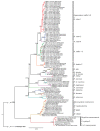Evolutionary relationships and population genetics of the Afrotropical leaf-nosed bats (Chiroptera, Hipposideridae)
- PMID: 32390744
- PMCID: PMC7197329
- DOI: 10.3897/zookeys.929.50240
Evolutionary relationships and population genetics of the Afrotropical leaf-nosed bats (Chiroptera, Hipposideridae)
Abstract
The Old World leaf-nosed bats (Hipposideridae) are aerial and gleaning insectivores that occur throughout the Paleotropics. Both their taxonomic and phylogenetic histories are confused. Until recently, the family included genera now allocated to the Rhinonycteridae and was recognized as a subfamily of Rhinolophidae. Evidence that Hipposideridae diverged from both Rhinolophidae and Rhinonycteridae in the Eocene confirmed their family rank, but their intrafamilial relationships remain poorly resolved. We examined genetic variation in the Afrotropical hipposiderids Doryrhina, Hipposideros, and Macronycteris using relatively dense taxon-sampling throughout East Africa and neighboring regions. Variation in both mitochondrial (cyt-b) and four nuclear intron sequences (ACOX2, COPS, ROGDI, STAT5) were analyzed using both maximum likelihood and Bayesian inference methods. We used intron sequences and the lineage delimitation method BPP-a multilocus, multi-species coalescent approach-on supported mitochondrial clades to identify those acting as independent evolutionary lineages. The program StarBEAST was used on the intron sequences to produce a species tree of the sampled Afrotropical hipposiderids. All genetic analyses strongly support generic monophyly, with Doryrhina and Macronycteris as Afrotropical sister genera distinct from a Paleotropical Hipposideros; mitochondrial analyses interpose the genera Aselliscus, Coelops, and Asellia between these clades. Mitochondrial analyses also suggest at least two separate colonizations of Africa by Asian groups of Hipposideros, but the actual number and direction of faunal interchanges will hinge on placement of the unsampled African-Arabian species H. megalotis. Mitochondrial sequences further identify a large number of geographically structured clades within species of all three genera. However, in sharp contrast to this pattern, the four nuclear introns fail to distinguish many of these groups and their geographic structuring disappears. Various distinctive mitochondrial clades are consolidated in the intron-based gene trees and delimitation analyses, calling into question their evolutionary independence or else indicating their very recent divergence. At the same time, there is now compelling genetic evidence in both mitochondrial and nuclear sequences for several additional unnamed species among the Afrotropical Hipposideros. Conflicting appraisals of differentiation among the Afrotropical hipposiderids based on mitochondrial and nuclear loci must be adjudicated by large-scale integrative analyses of echolocation calls, quantitative morphology, and geometric morphometrics. Integrative analyses will also help to resolve the challenging taxonomic issues posed by the diversification of the many lineages associated with H. caffer and H. ruber.
Keywords: Paleotropical; cryptic species; mtDNA; nuclear introns; phylogeny; species delimitation; systematics.
Bruce D. Patterson, Paul W. Webala, Tyrone H. Lavery, Bernard R. Agwanda, Steven M. Goodman, Julian C. Kerbis Peterhans, Terrence C. Demos.
Figures







Similar articles
-
The evolutionary history and ancestral biogeographic range estimation of old-world Rhinolophidae and Hipposideridae (Chiroptera).BMC Ecol Evol. 2022 Oct 3;22(1):112. doi: 10.1186/s12862-022-02066-x. BMC Ecol Evol. 2022. PMID: 36192699 Free PMC article.
-
Molecular phylogenetics of the African horseshoe bats (Chiroptera: Rhinolophidae): expanded geographic and taxonomic sampling of the Afrotropics.BMC Evol Biol. 2019 Aug 22;19(1):166. doi: 10.1186/s12862-019-1485-1. BMC Evol Biol. 2019. PMID: 31434566 Free PMC article.
-
How and why overcome the impediments to resolution: lessons from rhinolophid and hipposiderid bats.Mol Biol Evol. 2015 Feb;32(2):313-33. doi: 10.1093/molbev/msu329. Epub 2014 Nov 29. Mol Biol Evol. 2015. PMID: 25433366 Free PMC article.
-
Nuclear introns outperform mitochondrial DNA in inter-specific phylogenetic reconstruction: Lessons from horseshoe bats (Rhinolophidae: Chiroptera).Mol Phylogenet Evol. 2016 Apr;97:196-212. doi: 10.1016/j.ympev.2016.01.003. Epub 2016 Jan 28. Mol Phylogenet Evol. 2016. PMID: 26826601
-
Cryptic diversity in Hipposideros commersoni sensu stricto (Chiroptera: Hipposideridae) in the western portion of Madagascar.BMC Evol Biol. 2015 Oct 30;15:235. doi: 10.1186/s12862-015-0510-2. BMC Evol Biol. 2015. PMID: 26518602 Free PMC article.
Cited by
-
Bat species assemblage predicts coronavirus prevalence.Nat Commun. 2024 Apr 4;15(1):2887. doi: 10.1038/s41467-024-46979-1. Nat Commun. 2024. PMID: 38575573 Free PMC article.
-
Whole-genome Analysis Reveals Contrasting Relationships Among Nuclear and Mitochondrial Genomes Between Three Sympatric Bat Species.Genome Biol Evol. 2023 Jan 4;15(1):evac175. doi: 10.1093/gbe/evac175. Genome Biol Evol. 2023. PMID: 36546695 Free PMC article.
-
Nycteribiid bat flies (Arthropoda, Insecta, Diptera, Nycteribiidae) of Kenya.Zookeys. 2023 Jul 13;1169:65-85. doi: 10.3897/zookeys.1169.102800. eCollection 2023. Zookeys. 2023. PMID: 38328029 Free PMC article.
-
The evolutionary history and ancestral biogeographic range estimation of old-world Rhinolophidae and Hipposideridae (Chiroptera).BMC Ecol Evol. 2022 Oct 3;22(1):112. doi: 10.1186/s12862-022-02066-x. BMC Ecol Evol. 2022. PMID: 36192699 Free PMC article.
-
Remarkably low host specificity in the bat fly Penicillidia fulvida (Diptera: Nycteribiidae) as assessed by mitochondrial COI and nuclear 28S sequence data.Parasit Vectors. 2022 Oct 27;15(1):392. doi: 10.1186/s13071-022-05516-z. Parasit Vectors. 2022. PMID: 36303252 Free PMC article.
References
-
- Aellen V. (1954) Description d’un nouvel Hipposideros (Chiroptera) de la Côte d’Ivoire. Revue Suisse de Zoologie 61: 473–483. 10.5962/bhl.part.75404 - DOI
-
- Allen GM. (1921) A new horseshoe bat from West Africa. Revue de Zoologie Africaine 9: 193–196. 10.5962/bhl.part.24480 - DOI
-
- Allen GM. (1939) A checklist of African mammals. Bulletin of the Museum of Comparative Zoology at Harvard College 83: 1–763.
-
- Allen JA, Lang H, Chapin JP. (1917) The American Museum Congo Expedition collection of bats. Bulletin of the American Museum of Natural History 37: 405–563. 10.5962/bhl.title.82385 - DOI
LinkOut - more resources
Full Text Sources
Miscellaneous
